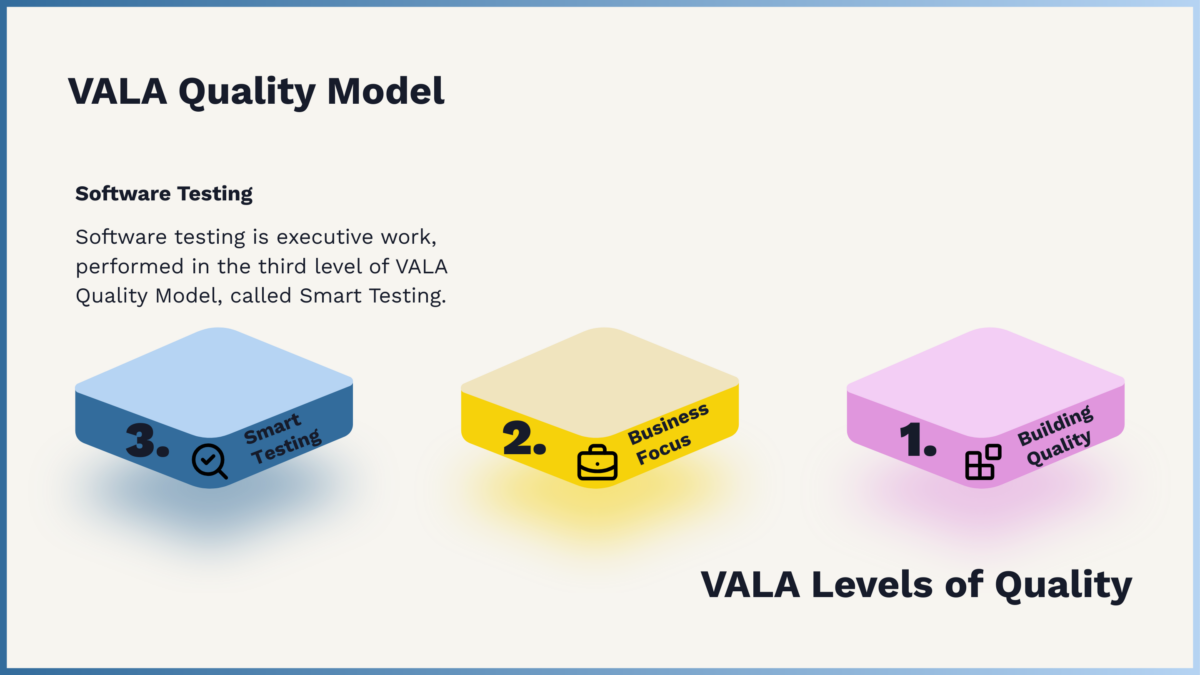Software Testing and Quality Assurance
Finland’s Leading Software Testing Service Provider
As the leading player in the field, we offer all services related to software testing.
Need something simpler? We also provide individual Software Testers to help you in precise needs and situations!
Why?
Why should you focus on software testing, and what can you achieve with it?
Software quality is one of the biggest deciding factors between success and failure. If the software doesn’t work as expected—if it’s slow, confusing, or unreliable—users will leave. And when that happens, it doesn’t matter how good the idea behind it was.
That’s why testing is not optional. It’s not just a box to check at the end of a project. It’s a core part of software development—a backbone. Quality issues can come from anywhere: usability, performance, security, functionality. Testing is how you stay ahead of those issues instead of chasing them later.
Underestimating testing is a common mistake. It can lead to poor quality, missed deadlines, and in the end, unhappy users. You might have the best developers, but without the right quality professionals working alongside them, the results won’t meet expectations.
Testing is often misunderstood as a cost with little return. But actually, good testing is one of the most valuable investments you can make in a software project. Why? Because the earlier you find and fix issues, the cheaper and easier it is to do so—and the better the final product will be.
There is no such thing as a defect-free development process. But with quality assurance as part of the workflow from day one, you catch problems when they’re still easy to fix. If you wait until the end, the same problems will cost far more time, effort, and money.
A solid testing process helps you avoid surprises late in the game. It builds confidence across the team. It strengthens your reputation. And most importantly, it keeps your users happy—which is ultimately the best measure of success.
In short: good testing won’t just save your project. It will help make it great.

Our work is always guided by VALA Quality Model. In it, due to its executive nature, Software Testing is in the third level called Smart Testing. Read more about our Quality Model here.
Want to know how we could improve your quality with software testing? Or why our clients see us as their No.1 preferred partner?

Software testing is not enough
Software testing is really important, but there’s so much more to software quality than just testing. Read this guide to understand why we should progress from mere software testing and assuring/assessing quality, towards building software quality, holistically and starting from culture.
“QA services are critical to our digital products. Because of this, the QA partner has to be able to perform beyond normal service delivery. We wanted a partner which can apply their knowledge in to the use of MTV and take their place as part of our development teams.”
– Jyri Kyllönen, Director of Digital Services and Development at MTV.

Our Software Testing service
How do we help you in practice?
VALA’s software testers bring with them a hefty dose of quality culture and mindset. VALA’s Quality Model supports our testers in all parts of their work, leading to simply better testing.
Software testing can be divided roughly into three main areas and six different testing levels. VALA testers handle all these areas and levels. Read more about these at the bottom of this page.
Benefits of working with VALA
We’re one of the biggest players in software quality in Finland, and as the Great Place to Work 2025 winner, we attract and retain the best specialists in the field. That means our clients get specialists who really know what they are doing.
With over 17 years of experience, we know what works and adapt to different industries and project needs.
We also have an active and engaged expert community that constantly shares knowledge. The best practices we develop don’t stay with one client—they spread across our people, meaning our clients benefit from the latest and smartest ways of working.
Our experts bring that kind of knowledge and expertise to our clients that the clients do not yet have and which is rather challenging to acquire. Modern software testing is not just mouse clicking, but rather something that requires comprehensive knowhow and experience. Through various customer projects and industries, we’ve gained an extensive overview of different working methods and -cultures, gathered best practices and learnt to avoid the worst pitfalls.
Want to dig deeper?
If you already know the basics, read our guide on Software Quality Guidelines to learn more!
Technologies & Tools
We are technology-agnostic. However, we handle all major test management tools, for example Jira compatible tools and Microsoft Azure DevOps testing tools. These tools include Xray, TestRail, Jira, Confluence, Browserstack, Sharepoint, Zephyr and Tricentis Tosca.
Similarly we use the most common tools in technical testing (interface testing, performance testing, load testing) tools e.g.: Postman, JUnit, Bash scripting, Swagger UI, NeoLoad, BrowserStack, Apache Jmeter, Locust, Dynatrace and K6.

Some of our Software testing references by companies and industries
Levels of software testing
As its name says, unit testing tests small parts of code, units. These are by principle the smallest parts of a software that can be tested. The goal is to make sure that these small parts are written correctly. Unit tests are usually automated and created at the same time as the actual development progresses.
System testing on the other hand is about the whole system and its different use cases.
The goal of Integration testing is mainly to test how the different parts of the software communicate with each other, in other words, how does the integration between them work.
Main areas of software testing
The purpose of functional testing is to ensure that the software works as it’s supposed to and fulfills the set functionality goals. It is usually done from the viewpoint of the end user and executed by using the actual user interface.
Regression testing includes the before mentioned levels of testing but is different by its nature. While functional (and non-functional) testing tries to find as many new defects and error situations as possible, regression testing on the other hand makes sure that new changes to the software haven’t broken any working functionalities.
Acceptance testing is usually done by the customer or their representative who checks whether the ready or almost ready product matches the requirements of the pre-determined use cases. Acceptance testing requires good knowledge of the business at hand, the requirements of the customers and the possible regulations and legislation in question.
As the name implies, non-functional testing is about testing the aspects that are not visible functionalities. These can be for example performance, security, tolerance to defects or use of resources.
Usability testing examines how well the software works in general – is it easy to use, is it intuitive and logical, are the colors, contrasts and transitions working well, are the loading times decent and so on. Depending on the device and the user group, the requirements for usability can vary a lot but, in all cases, there is a solid theory and good practices behind a good usability.
Exploratory testing is less systematic and relies on the expertise and experience of the tester. Usually the focus areas are predetermined, and a log is updated of what have been done and what were the findings. Exploratory testing can be a very efficient way to go through even complex things without having to deal with vast amount of preparations and documentation. Many times, the results can be surprising – during the sessions the testers can evaluate things from multiple perspectives and even unorthodox point of views are present, unlike in more systematical testing.
For more information









